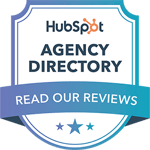
Want to grow your B2B business without constantly chasing the next big marketing fad? Organic growth is the answer. It's about building a solid foundation and attracting customers naturally through smart and strategic marketing.
The organic growth of a company is a strong indicator of its ability to attract and keep customers happy with what it offers and how it treats them.
Schwab's annual benchmarking report shows that, in 2023, firms managing $250 million or more in assets under management (AUM) achieved a median organic growth rate of approximately 5%, with top-performing firms reaching 12.2%. Additionally, Fidelity's 2024 RIA Benchmarking Study reports an average organic asset growth compound annual growth rate of 11% in 2023.
Viewing the business through the eyes of the ideal client drives consistent, year-over-year growth. High-growth firms often have a written strategic plan, including an ideal client persona, value proposition, and marketing strategy. These firms see at least 40% more new clients.
Let’s dive into organic growth strategies you can implement to achieve similar results.
What Is Organic Growth?
Organic growth is like nurturing a garden. Instead of buying new plants, you focus on making the existing ones thrive. It’s about leveraging internal strategies—think better marketing, stronger customer relationships, and innovative offerings—without relying on mergers, acquisitions, or major financial investments.
Unlike paid advertising, organic growth strategy focuses on building long-term relationships with your audience, attracting them through valuable content, and establishing your brand as a trusted authority.
Why does it matter?
- Sustainability: Organic growth fosters long-term business health.
- Cost efficiency: Unlike paid growth, it focuses on resources you already have.
- Brand loyalty: It builds trust and meaningful connections with your audience.
According to McKinsey, businesses that prioritize organic strategies are 1.5 times more likely to outperform their competitors over the long term.
Organic vs. Inorganic Growth
While organic growth focuses on internal efforts, inorganic growth often involves mergers, acquisitions, or aggressive paid campaigns.
Image source: Forbesburton
Organic growth marketing focuses on attracting customers naturally through valuable content, engagement, and consistent brand messaging. It’s about internal expansion, focusing on optimizing existing resources and enhancing internal capabilities. It requires consistent effort and strategic development for sustainable results.
Strategies of organic growth can be tailored to fit the specific needs and goals of any business, regardless of size or industry.
On the other hand, inorganic growth relies on external expansion through mergers, acquisitions, or investments. While offering rapid scaling, it carries higher risks and less control over brand integration and long-term stability.
Here's a concise comparison:
|
Organic Growth |
Inorganic Growth |
|
|
Focus |
Internal optimization and development |
External acquisitions, mergers, and investments |
|
Cost |
Lower, leverages existing resources |
High, requires significant investment |
|
Speed |
Gradual and sustainable |
Rapid scaling potential |
|
Risk |
Lower, controlled risk |
Higher risk due to integration challenges and market volatility |
|
Sustainability |
Long-term, sustainable growth |
Sustainability dependent on successful integration and market conditions |
|
Example |
Growing through content marketing |
Acquiring a competitor to increase reach |
When to choose which?
If you want steady and scalable growth, organic is your go-to. However, in highly competitive markets where speed is critical, inorganic growth may complement organic efforts.
4 Organic Growth Strategies for Increased ROI
Let’s dive into how you can take your marketing game to the next level with strategies that focus on organic growth and business success. Here's how to set the foundation for lasting results and ROI.
Strategy 1: Build a Customer-Centric Foundation
This is all about putting your customers first, understanding them deeply, and building strong relationships.
1. Do Your Homework and Conduct Thorough Market Research.
Image source: Ideascale
Effective marketing starts with knowing your market inside and out. This means understanding who your ideal customer is, what they need, and what your competitors are doing. Focus on three key areas:
- Get to know your audience: Go beyond basic demographics. Dive into their behavioral patterns, pain points, purchasing motivations, and online habits. What are their professional goals? What challenges do they face daily? Tools like LinkedIn Sales Navigator can provide valuable insights into professional demographics and interests.
- Check the competition: Don't just identify your competitors; analyze their strengths, weaknesses, marketing strategies, and online presence. Use tools like SEMrush (for example, to analyze competitor backlink profiles for content opportunities) and Ahrefs to uncover their keyword strategies, content performance, and overall market positioning. Find those gaps where you can stand out.
Ready to Outsmart Your Competition and Grow Organically?Smart growth starts with knowing your rivals. Discover opportunities with our free competitive insights report. |
- Data analytics utilization: Data is your best friend. Use analytics tools like Google Analytics 4 (GA4) for website insights, social media analytics for engagement metrics, and CRM data to understand customer behavior. Consider surveys and focus groups using tools like Typeform, and combine this with social listening platforms like Hootsuite to stay on top of your audience’s needs. This data should shape your decisions and help you track how well your campaigns are doing.
2. Develop a Unique Value Proposition (UVP)
Image source: Omniconvert
Now when you have the customer data, answer the question: Why should customers choose you over competitors? That’s your UVP. It’s the promise of value you deliver to your customers, clearly articulating why they should choose you over the competition. A strong UVP should be:
- Clear and concise: Easily understood and memorable, avoiding jargon or complex language.
- Customer-centric: Focused on addressing specific customer needs and solving their problems. What tangible benefits do they receive?
- Consistently communicated: Integrated into all your marketing materials, website copy, sales pitches, and customer interactions.
3. Foster Strong Customer Relationships
Image source: Tidio
Loyal customers are your best marketing asset. They not only make repeat purchases but also become brand advocates, spreading positive word-of-mouth.
- Personalized communication strategies: Tailor your communication to individual customer needs and preferences. Use CRM data to segment your audience and deliver targeted messages.
- Customer feedback integration: Actively solicit and incorporate customer feedback to improve your products, services, and overall customer experience.
- Customer loyalty programs: Implement programs that reward and retain loyal customers, such as exclusive discounts, early access to new features, or dedicated support.
Strategy 2: Build Your Own Audience and Establish Thought Leadership
Don’t just depend on borrowed platforms like social media. Build a loyal audience that engages with your brand on your own terms. This helps you control the relationship and deliver tailored value.
Being seen as an expert in your field is a powerful way to attract customers organically. Position yourself as a trusted expert by sharing unique insights, conducting research, or presenting original ideas. Use webinars, white papers, and LinkedIn posts to lead discussions in your niche.
Here's how to establish yourself as a thought leader:
1. Create High-Quality, SEO-Optimized Content
Content is the heart of organic marketing. It attracts, engages, and turns your audience into customers by giving them valuable information and positioning your brand as a go-to resource. It helps you establish your brand as a thought leader. But, in today's world of AI search, this means more than just traditional SEO.
Image source: Similarweb
- Focus on value: Create informative, relevant content that tackles your audience's problems, gives them useful insights, and offers practical solutions. Think blog posts, white papers, case studies, videos, podcasts, and infographics.
- Optimize for search (strategic SEO implementation): Optimize your content for both traditional and AI-driven search. This means:
- Keyword research: Use tools like Ahrefs or Semrush to find relevant keywords and understand what people are searching for. Think about long-tail keywords and questions people ask in search engines and AI chatbots.
- On-page optimization: Optimize on-page elements (title tags, meta descriptions, header tags) for both traditional search and Search Generative Experience (SGE). Keep your language clear and use a logical structure.
- Structured data markup: Use schema markup to give search engines more context about your content, which can improve visibility in both traditional and AI-driven search results.
- Build trust (E-A-T): Focus on Expertise, Authoritativeness, and Trustworthiness. Make sure your content is high-quality, accurate, and reliable. This is super important for AI search, as it prioritizes trusted sources.
- Optimize for AI search: Understand how AI search engines present information (like summaries or lists) and structure your content to match. Give direct answers and use simple language.
- Stay consistent: Publish regularly to keep your audience engaged and show search engines your website is active and relevant. Fresh content is also a plus for AI search.
Image source: Oktopost
2. Engage in Partnerships and Collaborations
Partnering with other businesses or influencers in your industry can significantly expand your reach and introduce your brand to a new audience.
- Identify synergistic partners: Look for partners who share your target audience and values.
- Make it a win-win: Focus on partnerships that benefit everyone involved.
- Look for co-marketing opportunities: Think about joint webinars, content collaborations, or cross-promotions.
|
For instance, a marketing automation platform can partner with a CRM provider to host a webinar on "Driving Revenue with Automated Sales and Marketing." They can use an AI-powered platform to offer attendees personalized content recommendations based on their industry and job role, and an AI chatbot to answer questions during the live Q&A. |
Ready to Outsmart Your Competition and Grow Organically?Smart growth starts with knowing your rivals. Discover opportunities with our free competitive insights report. |
Strategy 3: Create a Multi-Channel Presence
Don't put all your eggs in one basket. Distribute your content across various channels where your target audience hangs out.
Choose the right platforms
Focus on the platforms where your target audience is most active. For B2B, LinkedIn is often the primary platform, while X (formerly Twitter) can be valuable for quick updates and industry discussions. Instagram can be used for brand storytelling. Use features like LinkedIn articles, polls, and live video to get more reach and engagement.
Maximize content repurposing
Repurpose and scale your content for maximum reach. For example, a detailed blog post can become a podcast episode, an infographic, and a social media carousel. Tools like Canva and Otter.ai make repurposing efficient and impactful.
Engage and build community
Create a dedicated space (like a LinkedIn group or forum) where your audience can connect, share ideas, and learn from each other. This fosters a sense of belonging and strengthens your brand's relationship with its audience.
Share useful and valuable content, ask questions, reply to comments, and encourage interaction. Also, think about creating your own platform to connect directly with your audience, independent of social media algorithms.
Start a podcast or video series
Create valuable audio or video content that provides insights, interviews, or educational material relevant to your industry. This builds authority and attracts a loyal following.
Podcasts can increase consumer brand recall by 22%, engagement by 27%, and emotional responses by 23% compared to traditional TV content.
Moreover, the podcasting landscape is experiencing substantial growth. Edison Research reports a 37.5% increase in overall podcast listenership over the past three years, highlighting the medium's expanding reach and potential for B2B companies.
Strategy 4: Own Your Community Relationships
Your most valuable audience is the one you can reach directly. Owning your community relationships—like having an engaged email list—is one of the most reliable ways to grow sustainably.
- Convert followers into subscribers: Create gated content like eBooks, white papers, templates, or exclusive webinars to capture email addresses.
- Build loyalty through consistency: Whether it’s a weekly newsletter or a monthly resource drop, regular communication strengthens your relationship with your community.
Nurture Your Subscribers
Email marketing is still one of the most effective ways to nurture leads, build relationships with your audience, and drive conversions. It's about staying top-of-mind and providing consistent value and targeted content directly to your subscribers.
Image source: PPCRAO
- Segment your audience: Divide your email lists based on demographics, behavior, or interests. This allows you to send highly relevant messages that resonate with each group.
- Personalize your content: Craft personalized email content that addresses the specific needs and interests of each segment. You can include tailored product recommendations, relevant articles, or exclusive offers.
- Automate your email sequences: Use automated email sequences to nurture leads through the sales funnel and deliver timely information. This could include welcome emails, onboarding sequences, or follow-up emails after a purchase.
- Leverage AI for personalization: Use AI tools to analyze customer behavior and preferences, enabling you to send highly targeted emails at optimal times. Platforms like Mailchimp and HubSpot now offer AI-driven insights for email campaigns.
Organic Growth for Long-Term Success
So, how to grow a business organically? The answer lies in focusing on delivering exceptional value to customers, building a strong brand reputation, and implementing effective organic growth marketing. A clear understanding of the organic growth definition is fundamental for businesses aiming for sustainable, long-term success.
Implementing these organic growth strategies requires consistent effort and a long-term perspective. However, the rewards are substantial: sustainable growth, enhanced brand reputation, and strong customer relationships. By prioritizing organic methods, B2B businesses can cultivate a robust foundation for enduring success in a competitive marketplace.
Key Takeaways:
- Organic growth is sustainable and builds customer loyalty. It requires consistent effort and a focus on delivering genuine value to your audience.
- An effective organic development strategy combines high-quality content creation, customer-centric approaches, and continuous market analysis to drive long-term results.
- Experiment, measure, and refine. Not every strategy will work the first time, but data-driven adjustments will lead to success.
- A true organic growth business invests in its people, processes, and products to drive expansion.
- Stay authentic. Your audience values transparency and real connections over flashy tactics.
- Implementing these strategies requires time and effort, but the rewards are significant.
Ready to Outsmart Your Competition and Grow Organically?Smart growth starts with knowing your rivals. Discover opportunities with our free competitive insights report. |





